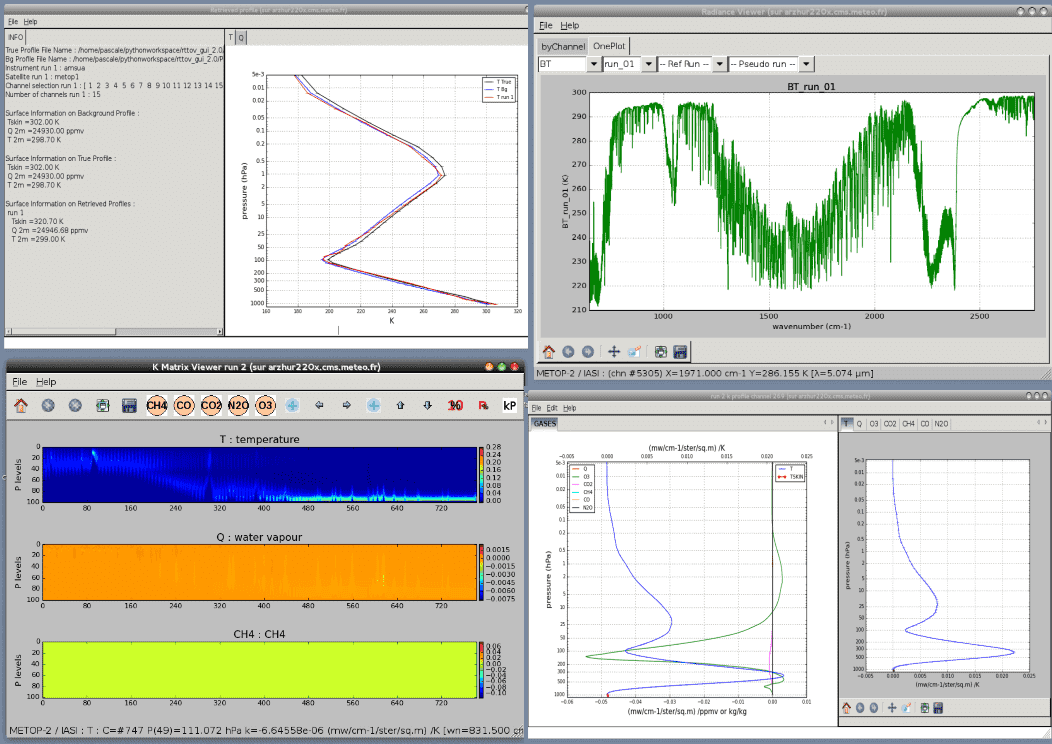Introduction
Current version: v13.2 December 2022
RTTOV Overview
Saunders, R., Hocking, J., Turner, E., Rayer, P., Rundle, D., Brunel, P., Vidot, J., Roquet, P., Matricardi, M., Geer, A., Bormann, N., and Lupu, C., 2018: An update on the RTTOV fast radiative transfer model (currently at version 12), Geosci. Model Dev., 11, 2717-2737, https://doi.org/10.5194/gmd-11-2717-2018.
Given an atmospheric profile of temperature, water vapour and, optionally, trace gases, aerosols and hydrometeors, together with surface parameters and a viewing geometry, RTTOV computes the top of atmosphere radiances in each of the channels of the sensor being simulated.
The core of RTTOV is a fast parameterisation of layer optical depths due to gas absorption which is described in the RTTOV v7 Science and Validation Report. In addition, RTTOV also optionally computes the Jacobian matrix which describes the change in radiance for a change in any element of the state vector assuming a linear relationship about a given atmospheric state. For a brief mathematical overview of radiative transfer modelling see this page.

More recent versions of the software have extended its capabilities in numerous ways. Since version 11, RTTOV has had a built-in GUI which allows the user to modify an atmospheric/surface profile, run RTTOV for a given instrument, produce radiances and brightness temperatures and display instantaneously the results. It is also possible to calculate Jacobians, run PC-RTTOV and perform a basic 1DVar retrieval. All this functionality is demonstrated in the EUMETSAT/ECMWF NWP SAF Satellite Data Assimilation course.
The most recent version of RTTOV is v13.2, released in December 2022.
Some example applications of using RTTOV software are given on the RTTOV applications page.
Obtaining RTTOV
RTTOV is available to licensed users free of charge. To become a licensed user of RTTOV, please register with the NWP SAF (or login if you have already done so) and add RTTOV to your list of software preferences. Older versions of RTTOV are available to download to maintain compatibility with certain software but are not supported by the NWP SAF.
It is recommended (though not mandatory) to compile RTTOV against the HDF5 library (v1.8.8 or later required). This enables the use of HDF5 format coefficient files (the preferred format for hyperspectral sounders), the land surface emissivity and BRDF atlases, and the RTTOV GUI.
In order to compile the RTTOV GUI or to call RTTOV from Python scripts you must also have f2py (part of NumPy) installed. Only Python3 is supported.
The GUI has additional requirements which are given in the GUI user guide.
In order to run the HTFRTC fast radiative transfer model through RTTOV you may optionally compile RTTOV against the NetCDF v4 library to use the smaller, faster netCDF coefficients files, but you can instead use the ASCII files.
Documentation and Resources
Instructions for compiling and running the most recent version of RTTOV may be found on the RTTOV v13 homepage. The User Guide also contains comprehensive details of the new features in RTTOV v13 and the changes from RTTOV v12. Further documentation including the RTTOV v13 Science and Validation Report can be found on the RTTOV v13 documentation page.
Resources (coefficients, atlases, etc.) compatible with RTTOV v13 can be accessed from the downloads page.
Details of future development planned for RTTOV can be found on the Future Plans page. Users wishing to make suggestions for new features should contact the Helpdesk.
Previous/other versions
- RTTOV-gb is a ground-based version of RTTOV based on RTTOV v11.2. You can download this package by updating your software preferences, but RTTOV-gb is NOT supported by the NWP SAF: see the official RTTOV-gb web page instead.
- RTTOV v12 is still supported by the NWP SAF, but where possible please update to v12.3 and apply any fixes for known bugs before reporting any issues. Coefficients and emissivity/BRDF atlases for RTTOV v12 remain available for download. Note that updated optical depth coefficients based on the v7/8/9 predictors which can be used with RTTOV v12 are available on the RTTOV v13 coefficients download page.
- RTTOV v11 is no longer supported by the NWP SAF, but remains available for download. If v11 is required, it is strongly advised to use v11.3 and apply any fixes for known bugs. Coefficients and emissivity/BRDF atlases for RTTOV v11 remain available for download. RTTOV v12 optical depth coefficient files (including the most recent v7/8/9 predictor coefficients available for RTTOV v13) can be converted for use with v11 using an executable which is compiled with RTTOV v12.
- Resources and documentation for RTTOV v10 and earlier can be found on the archived old site.
Publications
Application example
Comparison of real and simulated imagery. See one of the earlier featured aricles, Simulating satellite imagery to verify NWP models for forecasting for further information about simuilated imagery.
